
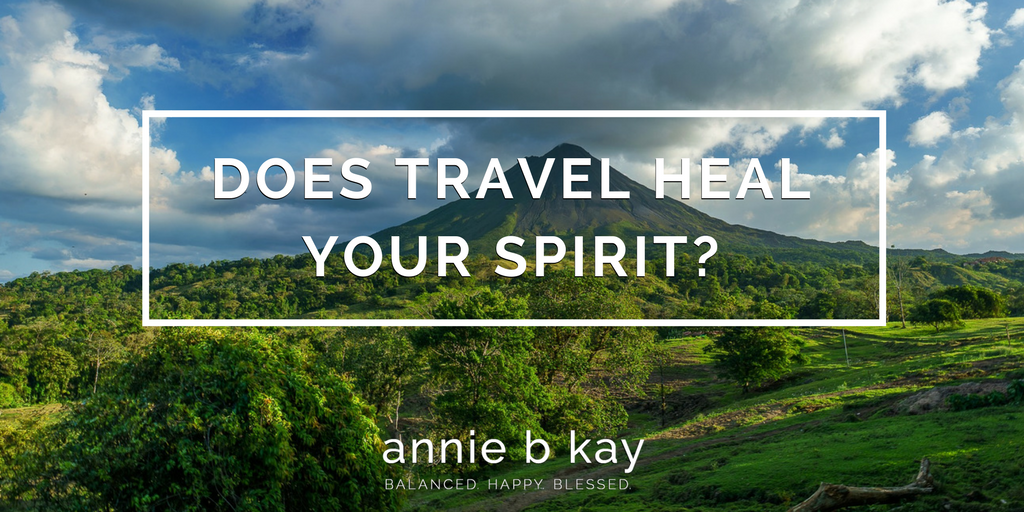
What is it about traveling that allows our spirits to soar?
As most of you know, I have lead programs at Kripalu for about a decade and received my yoga training there more than a decade before re-landing there as faculty. I have also studied with a teacher who loves to travel, and her inspiration has enabled two trips now that I will never forget – going to Damanhur in Italy for a dandelion initiation, and to Vieques to commune with the tropics and the ensparklated biobay there. Oh, and I lived part time on Kauai, part time on Nantucket for 13 years.
When guests come to Kripalu, it is often a spiritual pilgrimage. They save, sometimes for years, to be able to come. They dream of the transformation that getting away to a beautiful place, with loving expert teachers and guides, to practice soul-work with other aspirational beings, enables. Then they come, and it happens. It happens.
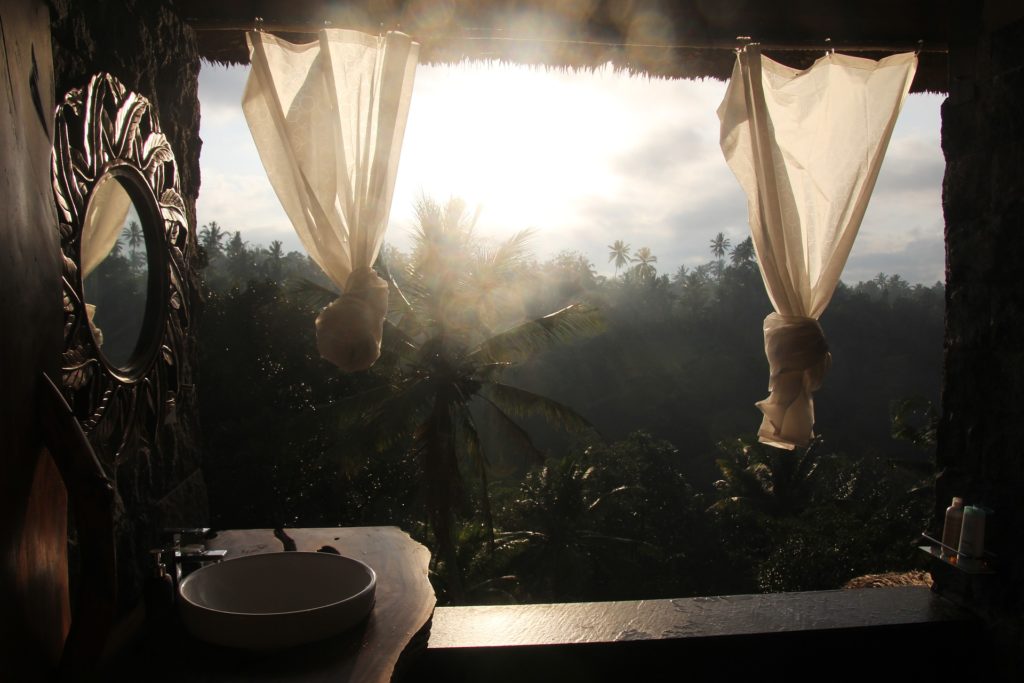
So, it is a milestone for me to offer my first tropical retreat. A group of us are going to a beautiful spa in Costa Rica in February, that magical land of mountains, tropics, monkeys in the trees, cloud forests and volcanos. We are going to have fun, do some yoga, connect with the medicine gardens at the spa where we will be staying, watch monkeys dance in the trees, meditate, clear, connect and recharge.
There is something about stepping out of your life, particularly to take a spiritual journey. It’s an opportunity to look at your life, appreciate it, and fine-tune your path. Somehow, meditation is more accessible. Somehow, insight is more accessible.
I know from the years I spent on Kauai and in other tropical locales that there is an energetic activation that also happens. The simplest way to say it is that it opens your chakras – the energy organs of your body. The tropics are incredibly expansive. So, doing energy work (like we’ll be doing in Costa Rica) allows big shifts to happen. It literally gives you an opportunity to re-arrange the building blocks of who you are.
So, for those of you going with me to the south, I am honored and eager to guide you on a gentle expansion – and for a few of you I’m sure, a great bursting open into new ways of being. I am creating ceremonies and rituals to guide us, speaking with the master gardeners there to ensure we connect with the magic of Costa Rica’s magnificent plant world.
As of this writing, there is still room in our tropical retreat. Interested in joining us? Check out this page for more information and to reserve your spot.
Whether you come with us or not, arranging your spiritual life with a collection of daily practices, regular connections and occasional journeys is a excellent mix that sparks and strengthens the soul and charges the spirit. May your path have more pleasure than pain, and take you home.
Namaste!

Pinterest
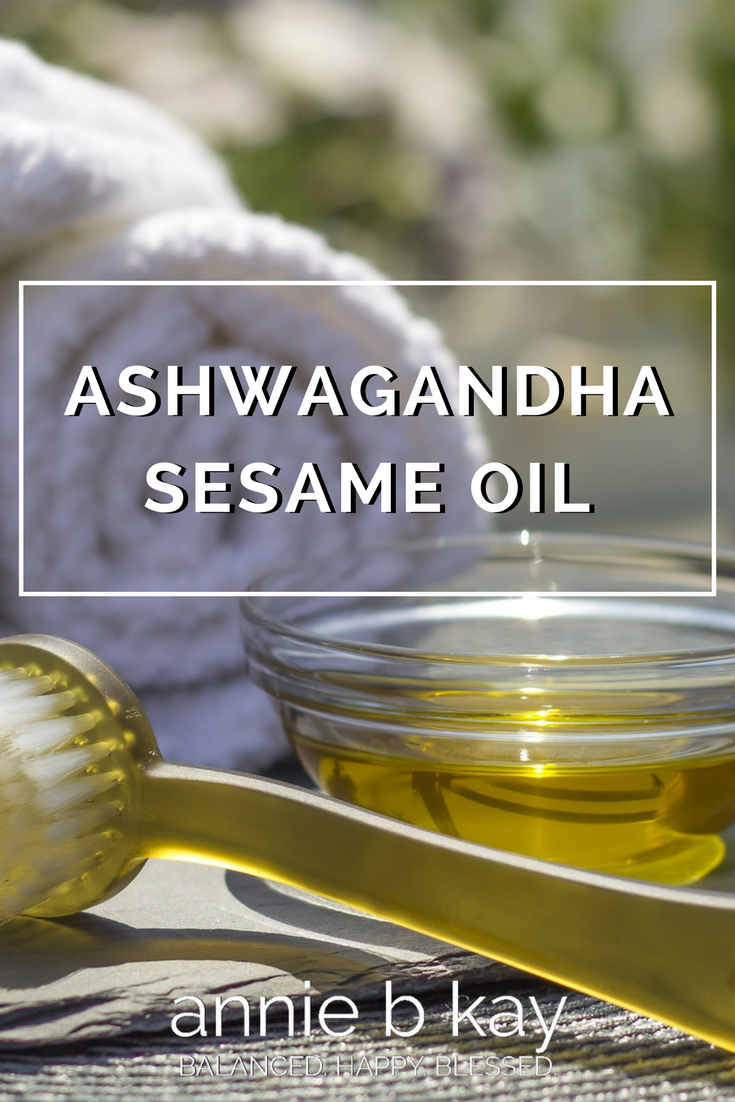
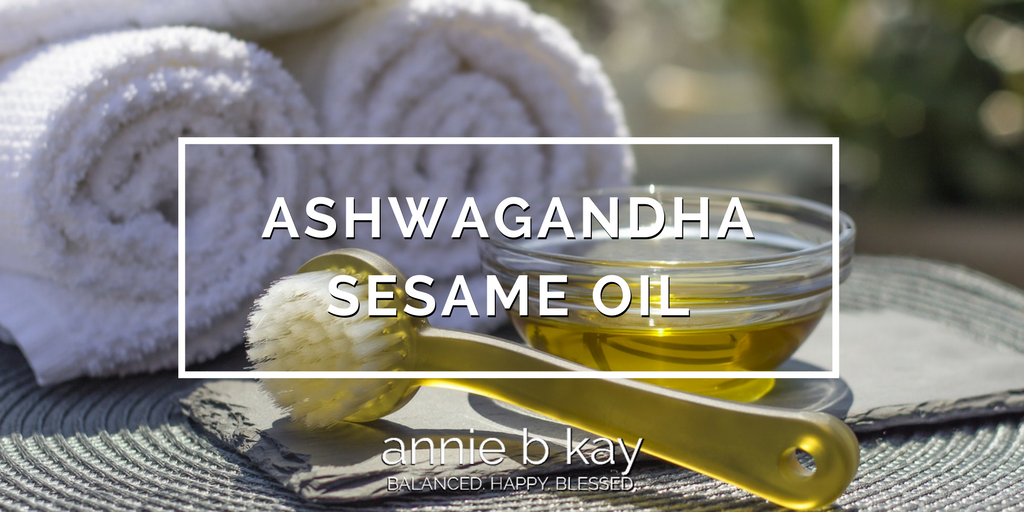
Tis the season to begin to think about making my fall batch of Ashwagnada sesame oil to warm our way through the fall.
Bows to my colleagues in the Kripalu School of Ayurveda (KSA). Several years ago I got to sit in on part of their training for Ayurveda Health Counselors and got a lovely intro to the Ayurveda way of herbs from Rosie Mann and the KSA faculty.
My husband and I both love this oil, and he has noticed how it is soothing and quiets his mind like it did mine the first time I practiced abhyanga (Ayurvedic oil self-massage) with it during my training. It does have a musky manly scent in sesame oil. We rub it on our feet at bedtime, and more widely when our minds get chattering too incessantly and we have time to relax (it can be a sedative, so I haven’t tried it on a workday yet).
Ashwa…what?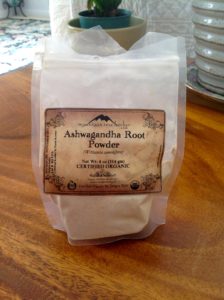
Ashwagandha is a root used in a number of Ayurvedic preparations. It’s a little famous for its aphrodisiac properties, but it is also calming and strengthening (ashwagandha means horse-smell in Sanskrit, after the musky scent of the root itself). Vata-pacifying, it is great for both my husband and I as we enter our hopefully wise Vata years of life.
Ashwagandha Sesame Oil Recipe
Ingredients
- 1/2 cup dried ashwagandha root
- 8 cups filtered water
- 2 cups organic sesame oil
Directions
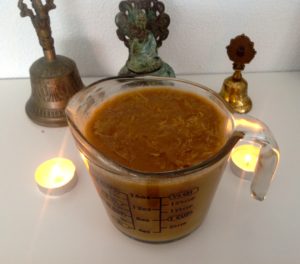 You will need a strainer and cheesecloth, as well as a medium-large saucepan and a container for the oil.
You will need a strainer and cheesecloth, as well as a medium-large saucepan and a container for the oil.
1. Gather all ingredients and bless them. I say a little prayer over them like the one my teacher Pam taught me, then ask the root to bless us with its healing gifts.
2. Pour water into the saucepan, and add ashwagandha root. Gently stir clockwise (only clockwise) with a wooden spoon or whisk.
3. Heat medium-low until reduced to 2 cups. This takes 2-3 hours. There is a point where the ashwagandha will thicken into the fluid – the texture will shift.
I like to let my botanical concoctions spend some time on the alter. Prayers, alters, it is all about infusing what I am making with love and intentions.
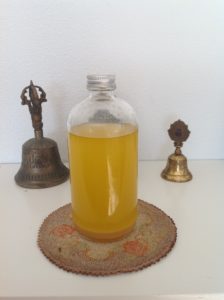 4. Rinse saucepan. Strain the fluid through a sieve, then strain several additional times through a cheesecloth until you have a thick fluid.
4. Rinse saucepan. Strain the fluid through a sieve, then strain several additional times through a cheesecloth until you have a thick fluid.
5. Pour this mixture back into the saucepan, and add sesame oil. Heat at low-medium, occasionally gently stirring clockwise. Again, you will see the oil change as it absorbs the ashwagandha root. I found it became richer and a smidgen cloudy (but, if I had strained more thoroughly it may be more rich yet clear)…the batch I have from the experts is more clear.
6. Once you see the oil change (this took about an hour), let it cool, then strain the oil off of the remaining root-water, into a clean glass jar.
7. Enjoy as a daily oil massage (I would do a test on the weekend!), or rub on your feet and/or top of your head before bed.
Namaste!
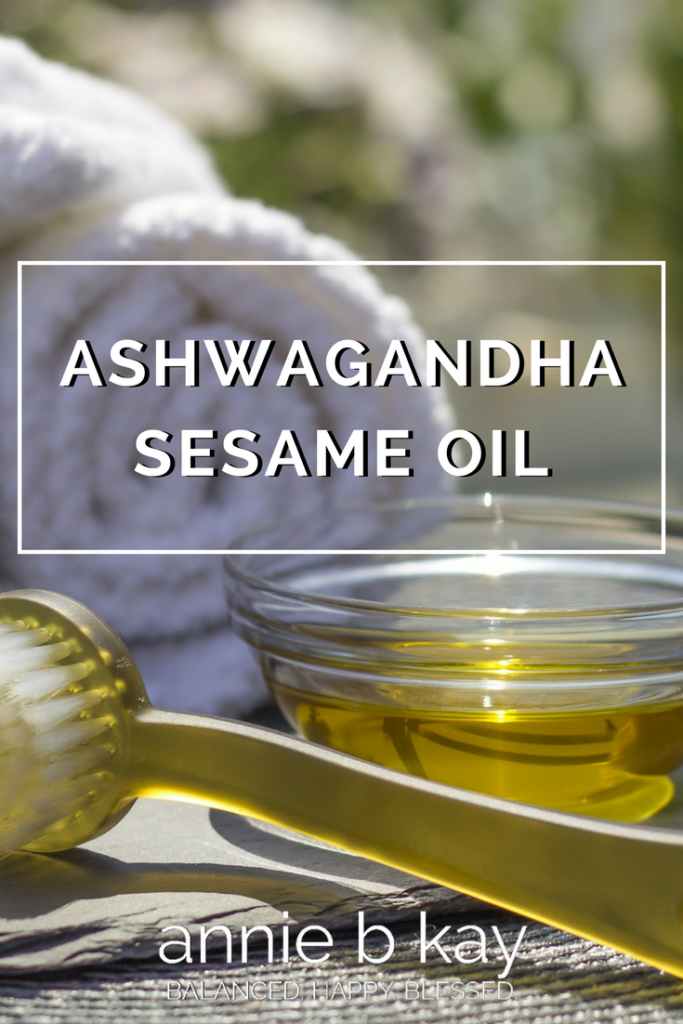
Pinterest
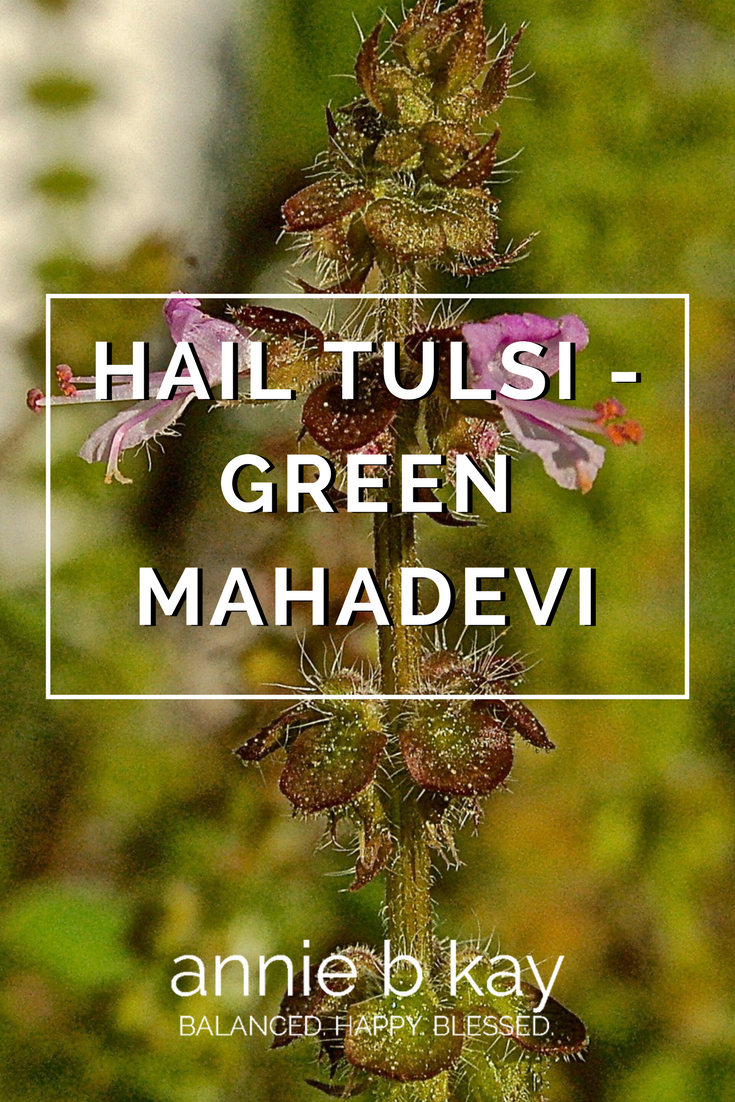
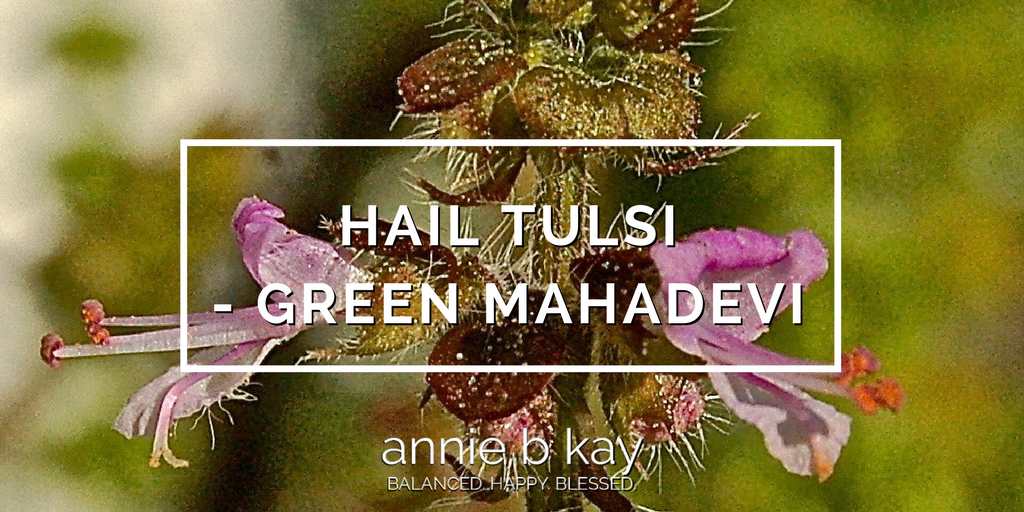
My garden right now is filled with the sweet green goddess known as tulsi.
Tulsi is a type of basil that originated in India. There are several types, like sisters in a family. If you ‘do yoga’, love botanicals, AND you haven’t met tulsi yet, I’m happy for you. Your future includes meeting one of the most sweetly powerful and healing herbs in the canon. I have great sisterhood with this plant and feel that I am introducing you to one of my coolest and best friends. When I refer to her, I am referring to the big T – the green goddess herself – tulsi.
A distinguishing feature of tulsi is its fragrance – it’s rich, buttery and flowery with an undertone of funk. Tulsi (which translates as “incomparable one” in Sanskrit) occupies an auspicious place in yogic/Ayurvedic tradition. It is thought to be an embodiment of the goddess Lakshmi, she of abundant good fortune, of being held in esteem in a community, and of generosity. In India, many homes have a tulsi plant at their doorstep, and women (and I’m sure men) have a tulsi plant near their bed so that the gentle breeze carries the scent of tulsi to them as they sleep, bestowing them with ageless beauty.
In the Garden
Much like the goddess, my tulsi seems to have a mind of her own. She goes where she wants, comes up really late (late June this year – thank goodness I held her space!). I have not been successful at growing her from seed so that I can get a jump on the season – nope, not how she’d prefer to roll. Yet, tulsi comes rolling back, year after year in her own preferred manner my garden. I often smell tulsi and then oh, there’s a plant popping up amongst the roses or corn.
I never needed tulsi seeds, though I’ve purchased many packets. My original tulsi plant came to me auspiciously – from Sweetwater Sanctuary in VT. Pam Montgomery gave me and my fellow apprentices plants (in 2013), and mine has happily multiplied into tulsiville.
Culinary & Preserving
I’ve tried for years to make a good oil infusion of tulsi but have been only modestly successful at capturing that unique fragrance in oil. Drying, I find, works best for me. I’ll then drink it as tea through the cooler months. If I have a gathering of gal herbalists I may attempt herbalist Brittany Wood Nickerson’s yellow cake which she served once incorporating dried tulsi….magnificent. She’s just come out with a cookbook filled with scrumptious herbal fare, but the way, which I strongly recommend.
You can also make a pesto with tulsi.
To dry tulsi or any herb (I have mugwort, cilantro, lemon balm and mint drying now), gather a bunch of it, tie it into a bundle at the stem, and hang in a place that will be warm and dry. Attics are great if they are reasonably well ventilated, and you can find a place to hang your crop. After a couple dry weeks (challenging this year), cut the bundle down. For plants that I intend to use as a tea of spices, I pull the dry leaves off the stem and place them in glass jars. Between Mason and jelly jars, you have a jar for any quantity of herb.
Medicinal & Energetic
From a Western medical perspective, tulsi is an adaptogen and has been studied for a variety of uses. Adaptogenic activity means that, like ginseng, it contains a complex array of phytonutrients that act in different ways but tend to overall support homeostasis – or healthful balance. So, tulsi tea is a terrific drink through the fall when back-to-whatever stress and cool winds conspire to give us colds and other crud.
Energetically, I’ve done a number of shamanic journeys with tulsi and here’s what I learned. Tulsi embodies all the goddesses of tantra – she’s Lakshmi, Deva, and yes Kali and all the rest – all rolled into one. She just might be the MahaDevi – the mother goddess. This is my own perspective colored, no doubt by my study of the goddesses of tantra. I know and love them, and draw on them often. In my study, these goddesses represent parts of ourselves (even if you are a man – we each contain both divine masculine and feminine within us). So, interestingly, I’ve found tulsi is energetically adaptogenic as well. From my discussions with other herbalists in my tradition who work energetically with plants, my view is not unique.
You can increasingly find tulsi plants and seed at your local garden shop. If not, try Mountain Rose Herbal or Horizon Herbs.
Have a beautiful day.
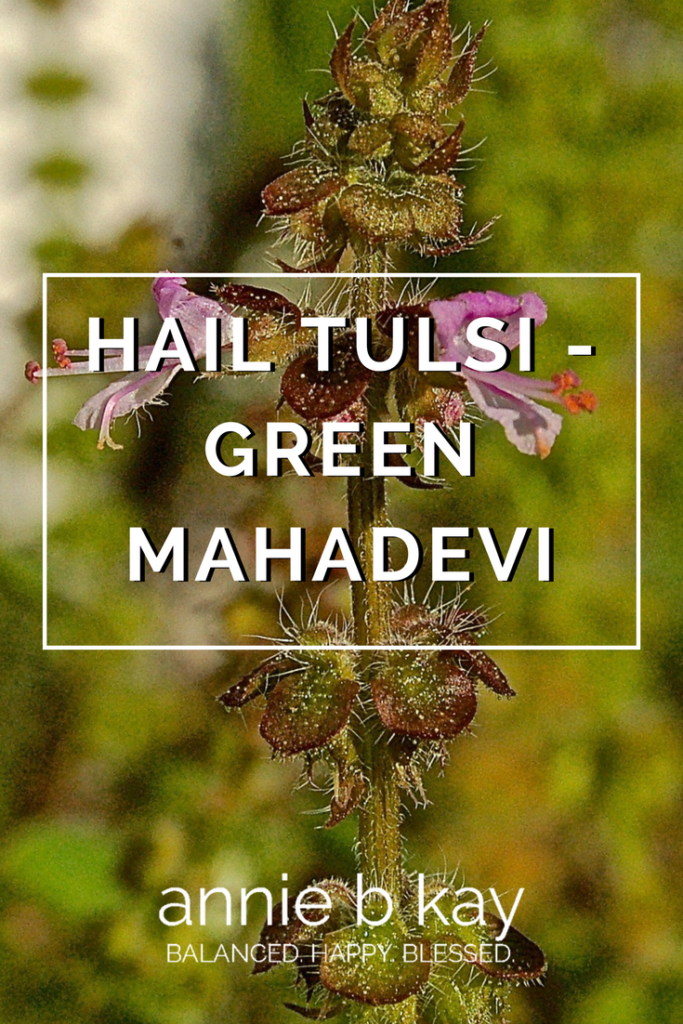
Pinterest
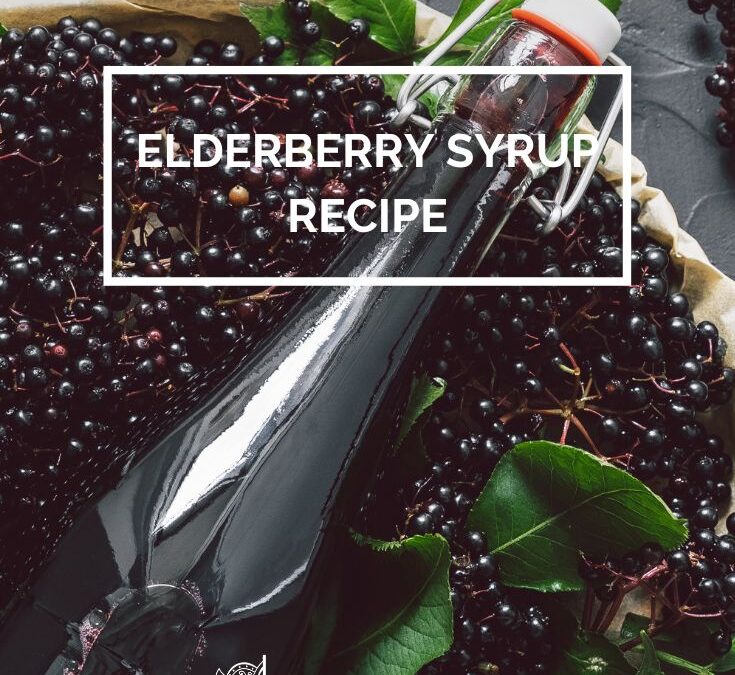
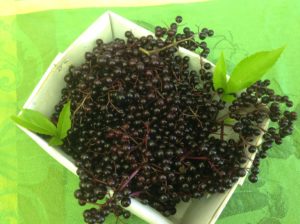
Deep purple elder-beauty
Updated 12/13/2023
I’ve been a smidgen obsessed with elderberry this year and it has heard my prayer. Not only did my husband gift me a beautiful elderberry bush for our yard, but a neighbor with a gorgeous mature bush gave us the green light to enjoy some of his bounty. So, I’ve been up to my elbows in elderberry.
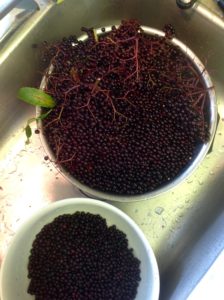
Give yourself time to rinse & remove stems
Elderberry is a folk medicine immune supporter, and even today you can find it in commercial cough syrup and lozenges. Clinical trials suggest that it reduces the duration of the flu, and it may have antiviral, anti-inflammatory and anti-cancer properties. From a plant-spirit energetic perspective, elder aids with journey work (such as shamanic visioning) and is, simply, an elder filled with primordial wisdom.
Most elderberry syrup recipes call for about 2/3 cup of berries for a season’s supply of syrup. Well, because I had a bucketful, mine is a little stronger! It’s delicious and rich. In the literature there are warnings about elderberry irritating the gut if taken raw and/or in excess, so you can overdo it! I intend to take 1 tsp daily for 3-5 days at the first sign of cold or flu.
Give yourself a couple of hours to make this start to finish. This recipe made about 6 cups of syrup.
Elderberry Syrup Recipe
Equipment
In addition to a large pot for cooking and processing, you will need a strainer or jelly bag, and containers for your syrup – I used jelly jars and processed them as if I were making jelly to give nicely sealed jars for gifts, and also kept a batch in a larger unsealed jar in the fridge to be used over the next 3 months by my family and me.
Jelly jars come with glass jars, a flat sealing lid, and a ring that twists over the sealing lid to keep it on the jar.
Ingredients
- 8 cups elderberry, washed and stems removed
- 4 cups water
- 1 Tbsp fresh ginger, peeled and sliced
- 5 whole cloves
- 1/2 tsp cinnamon, ground
- 1 cup honey
- 1-2 tsp pectin
Directions
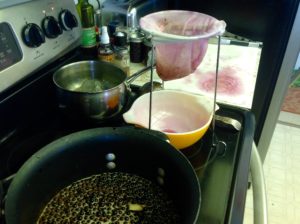
Full bedlam-making elderberry syrup
- Place berries, spices, ginger and honey in a large pot and bring to a rolling boil.
- Stirring, add pectin and boil for another minute.
- Lower heat to medium and simmer for 15-17 minutes.
- Strain through jelly bag, and place into jars.
As I mentioned I used jelly jars and processed them like jelly, which entails boiling the jars (pouring hot liquid into a cold jar can make it crack) and sealing the lids. After filling the jars with syrup and topping with sealing lids, I tightened the lid rings and placed the jars upside down for about 5 minutes. This helped them seal. Once that’s done, I check to see if the jar sealed by pressing the center of the lid. If I can push the lid down and it pops up, no seal. If the lid is concave and pressing it doesn’t move it, it’s sealed. Often, lids will seal throughout the day – I can hear “pop” from the next room when a lid seals. Jars that don’t seal need to be refrigerated, and the syrup used within 3 months. I keep those that seal all season.
Making your own jelly and syrup can be a sticky mess, but I am always amazed by the wonderful smell, color, and flavor of homemade preserves. It’s a fun thing to do with family or friends who are into it. Little jars of your handcrafted goods make terrific gifts. Make sure not to give away unsealed items or you may be gifting a nice jar of something not-so-healing.

Pinterest

 Updated: 5/16/2023
Updated: 5/16/2023
How many of you, when you look at how I describe myself, say to yourself “What the heck is plant alchemy?” Come on now, I know you do.
What Are Alchemists?
Alchemists were the scientists of the 16th century. They were a fascinating lot – a little scientific, a little more than a little out there. While they were the doctors and healers of their time, their obsession was transformation, most famously, the preoccupation of how to turn lead into gold.
Modern Day Alchemy
Alchemy today embraces the science, art, and spirit of healing. So, as a plant alchemist, I stay up on the science of plant-based diets for health, and the advantages and disadvantages of eating in this way. I also embrace the art of plants – of growing, cooking and living with plants, learning from them as they are our ancestors. I love herbalists and Ayurveda practitioners, as well as clinical nutritionists and naturopaths. Then, there’s the energetics of plants and nature. I’ve been diving into how we can use plants as an entree into ecstatic healing, and the many medicinal plants, including the astounding array of psychoactive plants as well as the much less dramatic, ones available to us for health and healing.
So, that’s plant alchemy, and that’s what I do – the science art and spirit of green beings. It’s very very good work if you can get it.
Energy Hygiene Practices
Within plant alchemy, energy hygiene has made a big difference in my life and I teach it all the time. For years now I’ve been doing a daily smudge with Paulo santo (a wood from South America) and I’ve fallen in love with the ritual and of course, I love love that beautiful smell. The smudge, wherein I light a piece of wood and scrub my energy body, is the greeting of the day “Hello tree, good morning stones, hi birds.” I then move my spine and undertake some fiery belly pranayama practice – stomach pumping, fire breath, a “take the whole thing and lift and throw it over your shoulder root lock” (or subtle version – a fine thread lifting version) – depending on my needs and the season. I give thanks, I make blessings, then move on with my day. In the shower, I have flowers or plant matter whenever possible, and as I shower I intentionally clear my energy field. Often, I will head outside to stomp around barefoot, grounding. All these practices – the daily fare of clearing and charging my energy field – are energy hygiene practices.
We modern humans can learn how to live our days in harmony with the earth and with nature. The earth and nature are changing, destabilized, and we feel it at our very cores. We can learn how to navigate that – how to ground ourselves when we need it, how to charge ourselves when we need it – by learning the skill of energy hygiene.
Learn more:
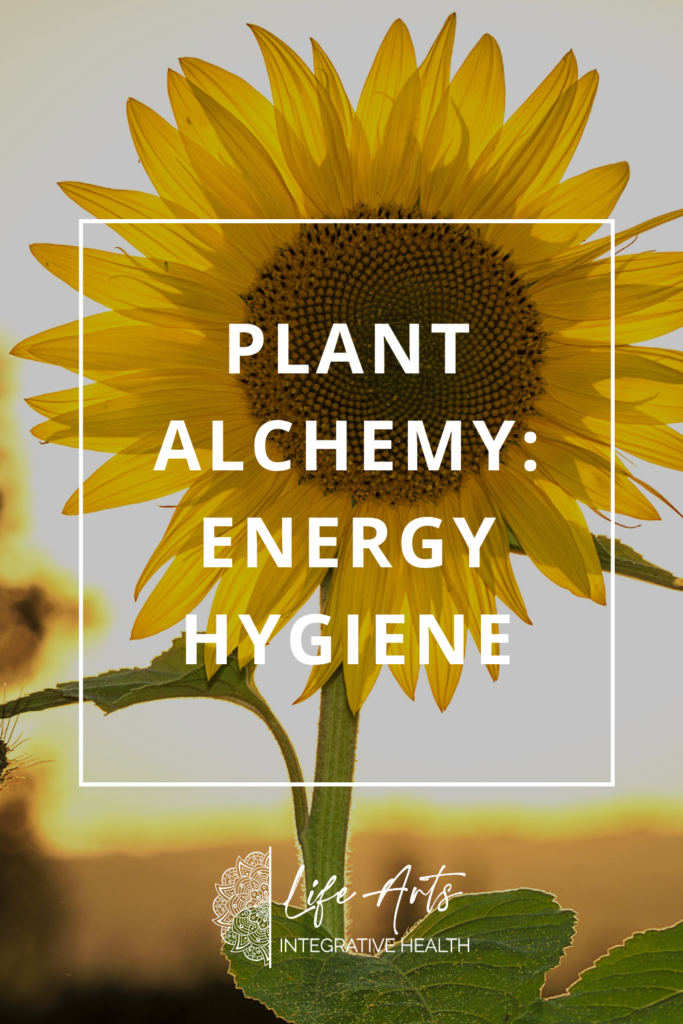
Pinterest


Last year I had an explosion of gorgeous chocolate sunflowers. Deep red petals in the sun, true beauty in their dark faces. So I saved them because I am the mistress of my garden and I believe in participating in the cycle of nature. I have a city of seed saving in my garage – white cosmos, zinnias, bachelor buttons and a collection of other things.
This morning I’m absorbed in the only somewhat painstaking task of flicking the seeds from the floppy dried heads of chocolate sunflowers, and there it is. A small worm, fat but only half the length of the nail on my pinkie. Then another. And another. They are crawling everywhere, and I notice that most of the seeds have one clean and tiny hole in them. Gross. Flower after flower, seed after seed after seed are crawling with baby worms.
And I think, here it is. As it ever was.
Humankind will not go down in a dramatic firey flame. It will be a little worm, or a small bug that gets in and eats away at that one essential element that we don’t know is the essential element until it’s gone. This is how it ever was.
We collect seeds for the next year, and the bugs and worms eat them. We pick them out, eagle-eye our beautiful seeds, and maybe if we are lucky we’ll have enough to plant. And maybe if we are lucky we’ll have a few come up. If we have nearly enough to eat then it will be worth it.
I’ve been thinking lately about the relationship of pain and bliss. One of my most beautiful friends recently died of an excruciating disease well before her time. She died with courage and compassion, awake. To what degree does the struggle in my life make my happiness sweeter, and to what degree does struggling just get me into the groove of suffering? Impossible to know, perhaps, without help or perspective.
My seeds aren’t my only garden struggle. My frangrant tulsi in organic cold pressed jojoba oil this year got moldy. I tended it daily but no mistaking that acrid smell of my lovely expensive oil gone rancid.
And yet, I will do it again.
I will practice – collecting seeds, making oils. Because in this crazy cyber-world, it ties me to the earth. It ties me to the history of those who went before, when the food went bad, when the seeds were eaten, when the earth determined in its impersonal yet I guess perfect way who lived and died and how that might unfold.
My heart breaks for people who are getting depressed because everyone’s Facebook page looks so much more interesting than theirs. Come on. We all know it’s not real. We all know that we are presenting a goofy, shiny, off kilter version of who we are.
Be authentic but look cute doing it, I call it. Life just isn’t like that.
So what do we do? We comfort each other. We save seeds. We make oils and share the best of ourselves as best we can and maybe, maybe not we actually touch one another. Look to nature. It’s messy and muddy and achingly beautiful.
You are nature, thus you are messy and muddy and achingly beautiful too.
Ah-ho-tai!
(translation: “How it is”, in Navaho)
Annie

Pinterest


























